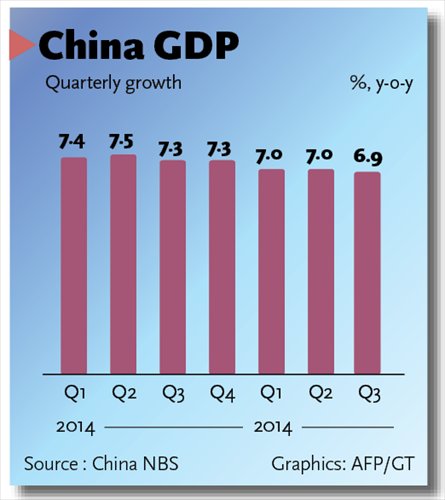
Slowest growth since 2009 is 'on normal track': NBS
China's economy grew by 6.9 percent in the third quarter, compared to the same period last year, down from 7 percent in the first two quarters and 7.3 percent for 2014, the National Bureau of Statistics (NBS) revealed on Monday.
It was the country's slowest growth since the second quarter of 2009.
Preliminary NBS data also showed that the country's GDP reached 48.8 trillion yuan ($7.67 trillion) in the first three quarters of 2015, up 6.9 percent from the same period last year.
The figures show that China's economy is generally "on the normal track" and is "progressing in a stable manner," NBS spokesperson Sheng Laiyun stressed during a press conference on Monday.
Chinese president Xi Jinping was also quoted by Reuters as saying on Saturday that the country's slowing economic growth was "normal as part of structural adjustments."
Li Daxiao, director of research at Shenzhen-based Yingda Securities, told the Global Times on Monday that the newly released GDP data "hasn't strayed too far" from the government target of 7 percent.
The Financial Times reported on Monday that China is "broadly on course" to meet its full-year growth target of about 7 percent.
Tian Yun, a research fellow at the China Society of Macroeconomics, also told the Global Times on Monday that the slower GDP growth is "in line with expectations."
"The 7 percent GDP growth in the first and second quarter has been driven to a great extent by performance of domestic stock markets. But this driving force has been dwindling since June, when the stock markets started to slump dramatically," he noted.
Sheng said that the lower-than-expected recovery of the global economy has suppressed China's exports, another reason that leads to slower GDP growth.
China's exports slumped 1.8 percent in the first three quarters, compared to the same period last year, the NBS said.
On the other hand, China is undergoing economic structural adjustments. China's overall industrial performance and GDP would be negatively affected by the easing of output from many traditional industries saddled with overcapacity, Sheng added.
Healthy momentum
According to the NBS data, above-scale industrial added value, a barometer of the health of industry, rose 6.2 percent year-on-year in the first three quarters, falling back from the 6.3 percent growth in the first half of the year.
Industrial enterprises saw a 1.9 percent slide in their profits from January to August, compared to the same period last year.
Above scale industrial enterprises are those whose revenues are above 20 million yuan annually.
But Sheng stressed that China's economic upgrading is showing a "healthy momentum," saying China's high-tech industries, including Internet and communications businesses, are growing fast.
China's service sector investment also increased 11.2 percent in the first three quarters, and the country's total fixed assets investments reached 39.4 trillion yuan in the first three quarters, up 10.3 percent from the same period last year but down from the 11.4 percent growth in the first half of 2015.
Tian, however, said that the above-scale industrial added value, along with a number of other economic data, indicates signs of a major industrial crisis which resembles the economic crisis China faced around 2009.
"Despite structural transformation, manufacturing will still be a primary driving force for domestic growth, and its current lackluster performance deserves attention as well as remedies," Tian noted.
He said that the government should take more measures to support domestic manufacturing, such as solving bad debts.
More rate cuts needed
Other data released together with the GDP figures also point to China's economic stability, Sheng said.
The Consumer Price Index, a main gauge of inflation, had a reasonable growth rate of 1.4 percent in the first three quarters against one year earlier.
Retail sales surged by 10.5 percent compared to a year earlier, up from the 10.4 percent growth from January to June, while the average per-capita disposable income climbed 9.2 percent.
Although the government has rolled out a number of monetary policies to prop up the domestic economy, Li said this is not enough. "It's necessary for the government to cut benchmark interest rates and bank's reserve requirements in the fourth quarter," he said.
The bank's reserve requirement ratio, or RRR, is the minimum level of reserves banks must hold.


















































